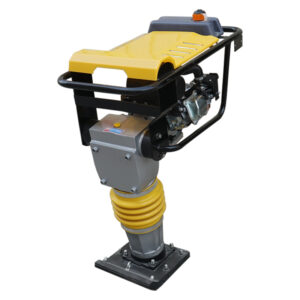
Have you ever filled in a hole and come back the next day to find a sunken area where your previously levelled ground was? If so, you probably learned a valuable lesson that day, compacting correctly is key. But you may not know how to go about choosing the right tool for the job and what the tools even are?
Tamping rammers are better for clay soils and smaller areas. They compact the soil through impact. Plate compactors are best for gravel, sand or silt and larger areas and compact through vibration. Consider your soil type and size of the job when choosing a tamping rammer vs plate compacter.
If you are a tradesman or even a DIYer, then you know how important your tools are, and that making the right choice saves you time, energy and money. We will go into detail on how soil type and job size affect each tool and see why it is essential you have the right tool for the right job. Once you know all these details, you can find the perfect tool to meet your needs.
Tamping rammer vs plate compacters
Tamping rammers are stronger and will compact deeper with clay soils but can’t be used with granular soils. Plate compacters are not as strong but can be used on larger areas and can also be used on all soils.
Like with most things in life, there cannot be a simple answer to this question but it is clear that plate compactor, also known as vibratory plates, are more versatile than rammers – which are also known as Jumping Jacks. You will have to first determine what soil you are working with and the size of your job before you will be able to know which compacting tool you should have. If you are going to be doing a multitude of different jobs, the best thing you can do for yourself and the people working with you is to get both. The time you save by using the right tool will pay you back tenfold.
What are Rammers and Compactors used for?
Rammers and compactors are used to compact soil. They create sturdy level ground for strong foundations or beautiful landscapes. Every contractor worth half his salt knows that dirt improperly compacted can spell disaster for any construction project.
These tools are used on every job, from the smallest of sidewalks to the tallest tower, and they come in all shapes and sizes. Without them ensuring level ground for solid foundations we would have collapsed roads and sidewalks, and our skyscrapers would be tumbling down.
What is the difference between a rammer and a plate compactor?
The difference between a rammer and a plate compactor revolves around it’s compaction method. A plate compactor uses vibration to encourage the soil to condense whereas a rammer compacts the soil through hitting the ground with force. A plate compactor is easier to use, a rammer requires you to have significant strength and vigilance- it delivers blows to the ground right near your feet.
| Plate Compactor | Tamper Rammer |
| Horizontal Design | Upright Design |
| Larger Areas | Smaller Areas |
| Granular Soils | Cohesive Soils |
| Vibratory Force | Impact Force |
| Easy Use | Professional Use |
What should I use to compact soils?
To compact soil, you should use either a tamping rammer or a plate compactor. If you have ever tried to compact soil without the right tools, you know it’s a near-impossible task. No matter how much you weigh, stomping the dirt is just not going to get it packed down correctly. Having a compactor in your arsenal is a must for anyone needing to compact soil. However, the type of soil you are working with will determine what tool is right for you.
How do you compact granular soil?
Plate compactors are best for compacting gravel, sand and silt, which is granular soil. Basically it is more efficient to use a plate compacter on any soil type that does not stick together when picked up. It’s rare to find clods of granular soil, and even when wet, you won’t be making mud pies with it as this soil type does not hold water.
Plate compactors work through a mixture of force and vibrations. They have a large surface area, and the plate vibrates up and down with extreme pressure to compact the soil beneath it. However, plate compactors do not have as much overt strength as a tamping rammer, so it is important to make sure you aren’t trying to pack down more than six inches at a time.
So if you are wondering what can I use to compact gravel and sand? then a plate compactor is your answer.
Which type of compaction is suitable for cohesive soil?
Tamping rammers, which are also known as jumping jacks, are the best tool for compacting wet, clay filled soils which also known as cohesive soil. This soil type may have a lot of clay in it, or in simple terms, if it were to rain it would hold the water. It’s excellent for mud baths and mud fights but can be a pain on the job site when trying to compact.

It can be a struggle to compact, because unlike granular soil, cohesive soil needs a specific percentage of moisture to compact correctly. But once you have that figured out, your rammer is going to be the clear star in this soil category. The tamping rammer has a smaller plate, compacting the soil through intense impacts. Because of its strength, you can compact deeper areas than you would be able to with a plate compactor. Due to the smaller plate, however, the area you compact at one time will be smaller.
So if you are wondering, how do you compact cohesive soil? then a tamping rammer is your answer.
What should I use to compact large areas?
To compact a large area, the plate compactor will often be the better choice. The large plate allows you to cover a much larger space in a shorter amount of time.
While granular soil is best suited to a plate compactor, it can also be used on both cohesive and granular soil, so it won’t matter what soil type your large job contains. But something to think about is if you are compacting soil that is deep, you may need to compact in layers or switch to a tamping rammer. However, if your job is granular soil, the tamping rammer will create a hole instead of correctly compacting the soil, so you will have no choice but to use the plate compactor one layer at a time.
How does a plate compactor work?
Plate compactors work by using vibration to get the job done. You push the machine across the surface being compacted, and its heavy, flat plate tamps down the soil by vibrating up and down. This movement forces the soil beneath to pack together.

Plate compactors are run on diesel or petrol. Vibrating plate compactors are also ideal for somewhat larger areas. This is simply because of the ease of use. Most compactors are quite wide and large, making them better suited to open areas. Similarly, plate compactors are better for flat surfaces and provide a uniform layer over such areas. As a result, this equipment is excellent for sub-base and asphalt driveways, parking lots and repairs. Furthermore, in locations a roller may not be able to reach, this machine can easily tamp.
How deep does a plate compactor compact?
Plate compactors compact to different depths, as they come in many different sizes, so the amount of force they drive into the ground will differ. Also, the soil type is going to determine how thick a layer of soil your compactor can manage. If you are lucky enough to have a large industrial size compactor, it is recommended to compact in layers or “lifts” of 12 inches when working with granular soil.
If you are working with cohesive soil, you would likely want to cut that number in half. For smaller compactors, no more than 6-inch lifts should be compacted at a time. Again, halve that number if working with cohesive soil. The compactor you buy will have specific recommendations, so always be sure and check your user manual for how to best use your machine.
What should I look for in a plate compactor?
Before deciding on a compactor machine for your use, carefully consider its characteristics.
Check the:
- Pounds of centrifugal force
- Vibration per minute (VPM)
- Plate’s durability
- Additional features you may need
According to Wacker Neuson’s National Product Specialist Jim Lewis, cast ductile iron plates are better suited for compaction, and a higher VPM is ideal for asphalt and granular materials.
Lewis adds professionals should rely more on the amplitude and weight to get an understanding of performance rather than the centrifugal force.
You can browse our professional range of plate compactors here.
How Does a Rammer Work?
Unlike a vibratory plate, rammers work by compacting the soil through direct impact. They deliver a strong force that compresses the soil, squeezing out any water and air with a frequency range of around 500-750 blows per minute. Through these impact blows, a rammer reduces the number of voids among the soil particles and increases the dry density of soil. This means, they are the best option for compacting cohesive and semi cohesive soils such as clay soils.
Tamping rammers, also called jumping jacks or jack rammers, are ideal for soil with a 13% moisture range which is generally soil that is difficult to break up when dry and does not crumble. A rammer also has a upright design which gives them a small footprint and means they are great in tight spots, trenches and ditches where there is not much room to manoeuvre. The shoe of the rammer (the base plate), is also not as wide as the plate of a vibratory compactor. A rammer also runs on fuel. Avoid using a rammer on gravel or asphalt, as it could damage the machine.
How deep does a rammer compact?
Rammers compact soil deeper than plate compactors.. For any tradesman, this is a valuable asset. Workers will not only have to fill less, but the overall number of passes is reduced. All in all, this leads to faster project completion and higher efficiency.
What should I look for in a rammer?
Similar to vibrating plate compactors, there are ways to minimize the vibration’s effects on an individual. Many sellers offer additional anti-vibrancy handles for worker health.
When purchasing a rammer, consider the engine. Most companies have turned to four-cycle engines rather than the old two-cycle ones to meet EPA emission standards and to overcome performance issues.
Unfortunately, two-cycle rammers offer several beneficial features, including the ability to add oil onsite (rather than undergoing oil changes and halting work). Luckily, two-cycle engines are on the market, with the notable Wacker Neuson continuing to manufacture two-cycle engines that meet EPA requirements.
Consider purchasing a rammer with a removable water tank and check the shoe stroke technology, compaction force, balance and blows per minute before making a decision.
Having Both
While vibrating plate compactors are best for larger areas and granular soils, jack rammers are an excellent choice for mixed or cohesive soil and smaller areas or trenches.
As you can see, professionals have a bit to chew on before deciding on a tamper rammer vs a plate compactor, and the projects they undertake largely influence purchasing decisions.
Because of these two machines’ adeptness at undertaking different jobs, many professionals choose to purchase both. By doing so, they ensure they have the equipment to take on any job in practically any location and save time on the job as well as wages for staff. The upfront investment in buying a rammer and a plate compactor quickly pays off.


